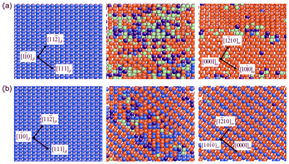 Developing an interatomic potential for martensitic phase transformations in zirconium by machine learning (用机器学习开发锆马氏体相变的原子间势)
Developing an interatomic potential for martensitic phase transformations in zirconium by machine learning (用机器学习开发锆马氏体相变的原子间势)
Hongxiang Zong (宗洪祥), Ghanshyam Pilania, Xiangdong Ding(丁向东教授), Graeme J. Ackland & Turab Lookman
npj Computational Materials 4:48 (2018)
doi:s41524-018-0103-x
Published online:24 August 2018
Abstract| Full Text | PDF OPEN
摘要:原子模拟为理解结构相变的物理机制提供了有效手段。但因经典的原子间作用势很难同时描述多型键合,因此对于某些具有同素异构转变的相变金属而言,揭示其结构相变的物理过程仍然面临挑战。基于机器学习(ML)技术,本研究开发了一种机器学习与相变理论相结合的方法(ML-AIMD),该方法使得描述相变的原子间作用势能够从头算分子动力学模拟(AIMD)中高保真地学习得到。我们以锆作为模型系统,证明了该方法的可行性和有效性。具体而言,我们基于ML-AIMD方法开发的原子间作用势所预测的声子、弹性常数和堆垛层错能等关键材料属性与实验或者第一性原理的计算结果相一致,并能够正确地描述金属锆中不同相结构之间的转变机制和预测压力-温度相图。
Abstract:Atomic simulations provide an effective means to understand the underlying physics of structural phase transformations. However, this remains a challenge for certain allotropic metals due to the failure of classical interatomic potentials to represent the multitude of bonding.Based on machine-learning (ML) techniques, we develop a hybrid method in which interatomic potentials describing martensitic transformations can be learned with a high degree of fidelity from ab initio molecular dynamics simulations (AIMD).Using zirconium as a model system, for which an adequate semiempirical potential describing the phase transformation process is lacking, we demonstrate the feasibility and effectiveness of our approach.Specifically, the ML-AIMD interatomic potential correctly captures the energetics and structural transformation properties of zirconium as compared to experimental and density-functional data for phonons, elastic constants, as well as stacking fault energies.Molecular dynamics simulations successfully reproduce the transformation mechanisms and reasonably map out the pressure–temperature phase diagram of zirconium.
Editorial Summary
Interatomic potentials: predicting phase transformations in zirconium (原子间作用势:预测锆的相变)
机器学习揭示了纯锆的原子间作用势,并预测锆的相变行为。来自中国西安交通大学丁向东教授(长江学者)课题组的宗洪祥博士和美国洛斯阿拉莫斯国家实验室的TurabLookman教授共同领导的团队,采用高斯型机器学习方法开发相变金属的原子间作用势,并基于此预测了纯锆的多型结构相变行为。他们通过局部原子环境的变化来表达每种原子的能量贡献,如键长、形状和体积,并基于机器学习模型成功地描述了纯锆的物理特性。进一步,通过大规模分子动力学模拟成功的预测出了纯锆在温度和压力共同作用下的相稳定性:锆的相图,该相图与之前的实验和模拟结果一致。使用机器学习开发描述相变系统的原子间势,可以帮助我们更好地模拟复杂系统。
Machine learning leads to a new interatomic potential for zirconium that can predict phase transformations. A team led by HongxianZong at Xi’an Jiaotong University, China, and TurabLookman at Los Alamos National Laboratory, U.S.A,used a Gaussian-type machine learning approach to produce an interatomic potential that predicted phase transformations in zirconium.They expressed each atomic energy contribution via changes in the local atomic environment, such as bond length, shape, and volume.The resulting machine-learning potential successfully described pure zirconium’s physical properties.When used in molecular dynamics simulations, it predicted a zirconium phase diagram as a function of both temperature and pressure that agreed well with previous experiments and simulations.Developing learnt interatomic potentials in phase-transforming systems could help us better simulate complex systems.


 沪公网安备 31010502006565号
沪公网安备 31010502006565号